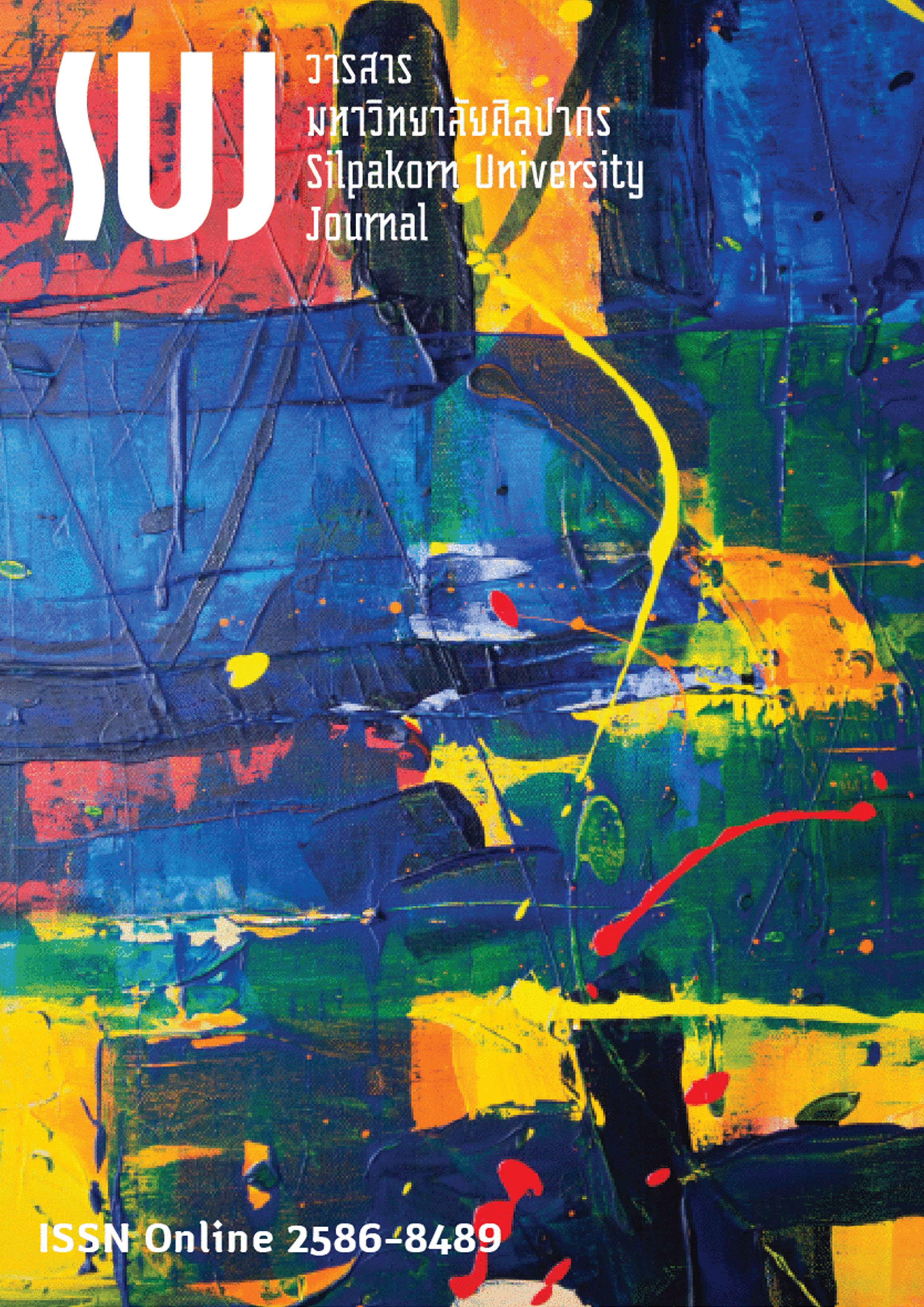การวิเคราะห์เนื้อหาการสื่อสารการตลาดผ่านสื่อสังคมของเว็บไซต์ขายของออนไลน์ (Content analysis of social media marketing communications of eCommerce websites)
Main Article Content
Abstract
การวิจัยครั้งนี้มีวัตถุประสงค์เพื่อ 1. ศึกษาประเภทเนื้อหาการสื่อสารการตลาด 2. ศึกษารูปแบบการสื่อสารการตลาด และ 3. ศึกษาการมีส่วนร่วมของผู้บริโภคที่มีต่อการสื่อสารการตลาดผ่านสื่อสังคมของเว็บไซต์ขายของออนไลน์ โดยใช้ระเบียบวิธีวิจัยเชิงปริมาณด้วยวิธีการวิเคราะห์เนื้อหาเชิงปริมาณของโพสต์ที่ปรากฏบนเฟซบุ๊กแฟนเพจและติ๊กต็อกของลาซาด้า (ประเทศไทย) และช้อปปี้ (ประเทศไทย) ตั้งแต่วันที่ 16 กรกฎาคม - 15 สิงหาคม 2564 จำนวน 541 โพสต์ ผลการวิจัยพบว่า 1) ประเภทเนื้อหาการสื่อสารการตลาดที่พบมากที่สุดบนเฟซบุ๊กแฟนเพจของเว็บไซต์ขายของออนไลน์ คือ การโฆษณาเพื่อส่งเสริมการขาย: สาระ/ประโยชน์ ร้อยละ 50.32 ส่วนประเภทเนื้อหาที่พบมากที่สุดบนติ๊กต็อกของเว็บไซต์ขายของออนไลน์ คือ การสื่อสารการตลาดอื่น ๆ: บันเทิง ร้อยละ 49.33 2) รูปแบบการสื่อสารการตลาดบนเฟซบุ๊กแฟนเพจของเว็บไซต์ขายของออนไลน์ที่พบมากที่สุด คือ ข้อความและภาพ ร้อยละ 75.32 ส่วนรูปแบบการสื่อสารการตลาดบนติ๊กต็อกของเว็บไซต์ขายของออนไลน์ทั้งหมดคือวิดีโอ 3) การมีส่วนร่วมของผู้บริโภคบนเฟซบุ๊กแฟนเพจของเว็บไซต์ขายของออนไลน์ที่พบมากที่สุด คือ การกดปุ่มแสดงอารมณ์ ร้อยละ 51.14 ขณะที่การมีส่วนร่วมของผู้บริโภคบนติ๊กต็อกของเว็บไซต์ขายของออนไลน์ที่พบเกือบทั้งหมด คือ การรับชม ร้อยละ 98.66 ผลการวิจัยจะช่วยให้นักสื่อสารการตลาดได้เห็นภาพประเภทเนื้อหาและรูปแบบการสื่อสารทางการตลาดบนสื่อสังคม รวมถึงการมีส่วนร่วมของผู้บริโภคในธุรกิจอีคอมเมิร์ซที่ประสบความสำเร็จในประเทศไทย การวิจัยครั้งต่อไปควรวิเคราะห์เนื้อหาเชิงคุณภาพ สำรวจความคิดเห็นของผู้บริโภคที่มีต่อการสื่อสารการตลาด หรือสัมภาษณ์เชิงลึกผู้ผลิตเนื้อหา
This research aims 1) to study content categories of marketing communications; 2) to study formats of marketing communications; and 3) to study consumer participations on official Facebook Fanpage and official TikTok of the two eCommerce websites in Thailand: Lazada and Shopee. Quantitative content analysis was employed to examine all posts on the social media from July 16 to August 15, 2021 with a total of 541 posts. The results showed that 1) promotional advertising—informative/beneficial content—was the most common category of marketing communications posted on the Fanpages of the eCommerce websites (50.32%). On the other hand, entertaining content was the most common category that could be found on TikToks of the eCommerce websites (49.33%). 2) Texts with images were the majority of common marketing communication formats appearing on the Fanpages of the eCommerce websites (75.32%). Apparently, short video was the only marketing communication format posted on Lazada’s and Shopee’s TikToks. 3) The most common consumer’s participation on the Fanpages of the eCommerce websites was emoji reactions (51.41%). Clearly, almost all the participation on TikToks of the eCommerce websites was viewing (98.66%). The findings will give marketing communicators a clearer picture of the content categories and formats of marketing communications, including consumer participation in the successful eCommerce businesses in Thailand. Future research should focus on qualitative content analysis, survey of consumer opinions on marketing communications, or in-depth interviews on the content provider side.
Downloads
Article Details

This work is licensed under a Creative Commons Attribution-NonCommercial-NoDerivatives 4.0 International License.
References
American Marketing Association. (2020). Marketing vs. Advertising. [Online]. Retrieved July 28, 2021 from https://www.ama.org/pages/marketing-vs-advertising
Bangkokbiznews. (2021). Surge in eCommerce-Food Delivery via Application from ‘WFH’-‘Covid’ Pushes Thailand Shopping Top of the World (อีคอมเมิร์ซ-สั่งอาหารผ่านแอพ’ พุ่งรับ ‘WFH’ -’โควิด’ ดันไทยช้อปติดอันดับโลก). [Online]. Retrieved June 7, 2021 from https://www.bangkokbiznews.com/news/detail/932692
Chaffey, D. (2021). The Content Marketing Matrix. [Online]. Retrieved July 30, 2021 from https://www.smartinsights.com/content-management/content-marketing-strategy/the-content-marketing-matrix-new-infographic
Chaisuwan, Bu-nga. (2015). Social Media Marketing Communication: Overview and Conceptual Framework (การสื่อสารการตลาดผ่านสื่อสังคม: ภาพรวมและกรอบแนวความคิด). Journal of Communication and Innovation NIDA, 2(1): 173-198.
Department of Disease Control. (2021). Corona Virus Disease (Covid-19) (โรคติดเชื้อไวรัสโคโรนา 2019 (COVID-19). [Online]. Retrieved June 5, 2021 from https://ddc.moph.go.th/viralpneumonia/index.php
Department of Industrial Promotion. (2016). Marketing Communications for SMEs (การสื่อสารการตลาดสำหรับ SMEs). [Online]. Retrieved June 26, 2021 from https://bsc.dip.go.th/th/category/2017-10-27-07-51-56/2017-11-13-09-53-59
Dodson, I. (2016). The Art of Digital Marketing: The Definitive Guide to Creating Strategic, Targeted and Measurable Online Campaigns. Hoboken: Willey.
Infoquest. (2021). Thailand Media Landscape 2021: Social Media (ภูมิทัศน์สื่อไทย 2564: โซเชียลมีเดีย). [Online]. Retrieved August 24, 2021 from https://www.infoquest.co.th/thailand-media-landscape-2021/social-media
Jayasingh, S., & Venkatesh, R. (2015). Customer Engagement Factors in Facebook Brand Pages. Asian Social Science, 11(26): 19-29.
Kumar, A., Bezawada, R., Rishika, R., Janakiraman, R., & Kannan, P. K. (2016). From Social to Sale: The Effects of Firm-Generated Content in Social Media on Customer Behavior. Journal of Marketing, 80 (1): 7-25.
Lazada Thailand. (2021). About. [Online]. Retrieved June 27, 2021 from https://group.lazada.com/en/about
Memon, M. (2021). How long should a video Be? video length best practices [2021]. [Online]. Retrieved June 22, 2021 from https://visme.co/blog/video-length/#facebook-video-length
Muangtum, Nattapon. (2021, February 25). Thailand Digital Stat 2021 from We Are Social (รายงานสถิติ Thailand Digital Stat 2021 จาก We Are Social). [Online]. Retrieved June 9, 2021 from https://www.everydaymarketing.co/knowledge/thailand-digital-stat-2021-we-are-social
Natthorn. (2021). Survey Results by Live Agent Reflect Insights that Online Shoppers Prefer Human Response to Chatbot (ผลสำรวจ Live Agent สะท้อนอินไซต์คนซื้อของออนไลน์ชอบคนจริงตอบแชทเหนือแชทบอทเหตุพอใจสูงกว่าหลายด้าน). [Online]. Retrieved July 1, 2021 from https://liveagent.asia/30609
Öztürk, M., & Batum, T. P. (2018). How Housing Brands Use Social Media in Their Marketing Communications?: A Content Analysis. Journal of Administrative Sciences, 17(33): 111-135.
Seric, M. (2018). Content Analysis of The Empirical Research on IMC from 2000 to 2015. Journal of Marketing Communications, 24(7): 647-685.
Shopee Thailand. (2021). About. [Online]. Retrieved June 27, 2021 from https://careers.shopee.co.th/about
Tassawa, C. (2019). Factor Influencing Facebook Page Posts’ Likes, Shares, and Comments in Sport Marketing. ABAC Journal, 39(3): 56-69.
Tuckwell, K. J. (2011). Integrated Marketing Communications: Strategic Planning Perspectives (3rd ed.). Toronto: Pearson Canada.
Vaiciyukynaite, E., Massara, F., & Gatautis, R. (2017). An Investigation on Consumer Sociability Behaviour on Facebook. Inzinerine Ekonomika-Engineering Economics, 28(4): 467-474.
Wiese, M., Martinez-Climent, C., & Botella-Carrubi, D. (2020). A framework for Facebook Advertising Effectiveness: A Behavioral Perspective. Journal of Business Research, 109: 76-87.
Wongreanthong, Nuttaputch. (2014). Content Marketing: Hooking Audiences with Story Telling to Make Brand Popular (Content marketing เล่าให้คลิกพลิกแบรนด์ให้ดัง). Bangkok: Nation Books.
Wongreanthong, Nuttaputch. (2017). Marketing Fast Forward: Changing Marketing in the Digital Age (Marketing Fast Forward พลิกการตลาดในโลกยุคดิจิทัล). Nonthaburi: Double U Publication.
Zeljko, D., Jakovic, B., & Strugar, I. (2018). New methods of online advertising: social media influencers. In B. Katalinic (Ed.), Proceedings of the 29th DAAAM International Symposium, (pp. 0041-0050). Vienna: DAAAM International.


